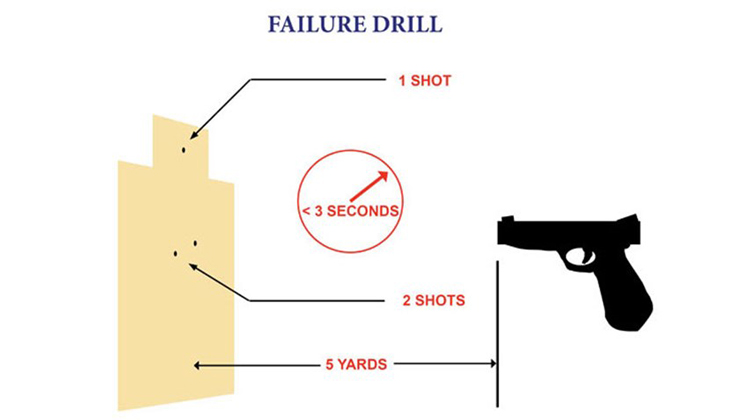
During the Mozambique war of independence, a mercenary named Mike Rousseau had occasion to be jumped by a terrorist at very close range. Rousseau applied two shots from his pistol, I believe it was a Hi Power, to the vital zone of his attacker. The results were not satisfying, as the attacker stayed on his feet and remained a threat. Rousseau then tried for a head shot, instead hitting the bad guy high in the throat and severing the spinal column which ended the encounter.
Sometime afterward, Col. Jeff Cooper heard about the incident and incorporated it into a Gunsite training exercise that he called the Mozambique Drill. For whatever reason, over the years, the exercise has come to be called “The Failure Drill.”
The justification for the exercise is the fact that we have applied two hits to the vital zone of the attacker and he is clearly unimpressed with the results. This can be for several reasons. He may be wearing body armor, or he may be high on drugs or alcohol and his confused body simply has not gotten the instruction to cease and desist. When confronted with an armed threat, the reason for the failure is really academic. It doesn’t matter why he is still a threat; he has got to be stopped and stopped soonest. Therefore, we fire the third shot at the head in order to impact the central nervous system and shut him right down.
But the challenge is not to simply make a head shot. The challenge is to put the shot into the head at the location most likely to stop things. It is important to remember that the forehead consists of the thickest bone in the head. I have personally investigated one case where a pistol bullet fired to the forehead failed to penetrate, simply making a surface wound and glancing off, and I have reliable information about many other such failures.
The justification for the exercise is the fact that we have applied two hits to the vital zone of the attacker and he is clearly unimpressed with the results.
To be reliably successful, the bullet must be delivered to that part of the head where bone is the thinnest. Imagine an upside-down triangle consisting of the line of the eyebrows and going down to a point at the center of the upper lip. A pistol bullet delivered to this area may be expected to impact the brain or the brain stem and effectively neutralize the threat.
The exercise is conducted in this manner. Two shots are delivered to the vital zone as quickly as possible, still being assured of center hits. As the pistol comes down out of recoil, the sights are again acquired and the target assessed. If the target is still up and still armed, a deliberate third shot is fired to the head, with the tip of the nose being a good aiming point. The exercise, therefore, is not three rapid shots, but two shots, pause (assess), fire the third shot.
The challenge of the Failure Drill is that it is easier to describe than it is to perform correctly. With the adrenaline flowing, it is difficult to deliver two fast shots and then slow down enough to make that third shot accurate (remember that Mike Rousseau missed the head completely). I see students having trouble with this in class, so you can imagine how difficult it would be in an actual gunfight.
Another challenge is the fact that the criminal’s head is not going to be nice and still like that silhouette target that we practice on. It is going to be moving and it is going to be moving erratically. Ask any hunter who has tried to shoot a wild turkey in the head with a .22 rifle.
Gunsite uses a robot, with a bad guy target attached, to demonstrate this. As the target attacks you, the two vital zone hits are not all that difficult if a person will pay due attention to his front sight. But that head shot, as the robot bumps along over rocky ground, can be quite a challenge.
Regardless, it can be done and it has been done. But the defensive shooter can’t just talk about it and think about it. He has to practice it and practice it a lot. Due attention to the front sight, a smooth, clean trigger press, and lots of practice, will get the job done.
Some have suggested that, because the head shot is so difficult, the proper third shot should go to the pelvic girdle. The problem with this thinking is that a shot to pelvis might work and it might not; it all depends on where on the pelvis the shot impacts. The best effect would be a shot delivered to the hip joint, not the center of the pelvis. When properly applied, this will generally put the attacker down, but it hasn’t taken him out of the fight. He may still be lucid and dangerous.
The defensive shooter must realize that the Failure Drill is an effective way to stop a violent attack. But he must also realize that it is a very difficult technique to deliver effectively and properly. It calls for a lot of concentration on proper shooting skills and lots of good practice.






















![Winchester Comm[94]](/media/1mleusmd/winchester-comm-94.jpg?anchor=center&mode=crop&width=770&height=430&rnd=134090756537800000&quality=60)
![Winchester Comm[94]](/media/1mleusmd/winchester-comm-94.jpg?anchor=center&mode=crop&width=150&height=150&rnd=134090756537800000&quality=60)












